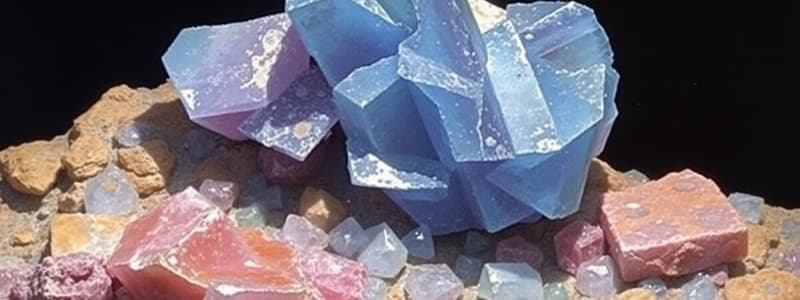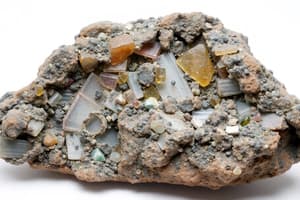Podcast
Questions and Answers
What is a defining characteristic of minerals?
What is a defining characteristic of minerals?
- They are solids with a crystalline structure (correct)
- They are always colored
- They are formed only through volcanic activity
- They can be organic
Which of the following best describes what happens when minerals form from magma?
Which of the following best describes what happens when minerals form from magma?
- All minerals must crystallize slowly
- Evaporites are formed
- Small crystals form from rapidly cooling magma (correct)
- They always form large crystals
Which mineral property is considered the most reliable clue for identification?
Which mineral property is considered the most reliable clue for identification?
- Cleavage (correct)
- Color
- Streak
- Luster
Which statement about streak is correct?
Which statement about streak is correct?
What are evaporites?
What are evaporites?
Which property describes how a mineral reflects light?
Which property describes how a mineral reflects light?
What do we call a mineral that breaks along weak atomic bonds?
What do we call a mineral that breaks along weak atomic bonds?
Which of the following minerals is NOT classified as a silicate mineral?
Which of the following minerals is NOT classified as a silicate mineral?
What primarily composes rock-forming minerals?
What primarily composes rock-forming minerals?
Which of the following mineral types makes up approximately 96% of the minerals in Earth's crust?
Which of the following mineral types makes up approximately 96% of the minerals in Earth's crust?
What defines a mineral as an ore?
What defines a mineral as an ore?
Which of the following characteristics is NOT used for identifying minerals?
Which of the following characteristics is NOT used for identifying minerals?
Which type of mineral is composed of the sulfate ion (SO42–)?
Which type of mineral is composed of the sulfate ion (SO42–)?
What element is primarily found in native elements?
What element is primarily found in native elements?
Which of the following minerals is classified as an oxide?
Which of the following minerals is classified as an oxide?
Which special property describes minerals that display different colors when viewed from different angles?
Which special property describes minerals that display different colors when viewed from different angles?
Flashcards
What is a mineral?
What is a mineral?
A naturally occurring, inorganic solid with a specific chemical composition and a defined crystalline structure. It's formed through natural processes, not by living things.
How are minerals formed from magma?
How are minerals formed from magma?
Minerals are formed from the cooling and solidification of molten material called magma.
How are minerals formed from solutions?
How are minerals formed from solutions?
Minerals can also form from the evaporation of water containing dissolved minerals, leaving behind solid crystals.
What is luster?
What is luster?
Signup and view all the flashcards
What is streak?
What is streak?
Signup and view all the flashcards
What is cleavage?
What is cleavage?
Signup and view all the flashcards
What is fracture?
What is fracture?
Signup and view all the flashcards
How reliable is color for mineral identification?
How reliable is color for mineral identification?
Signup and view all the flashcards
Mineral Hardness
Mineral Hardness
Signup and view all the flashcards
Crystal Shape
Crystal Shape
Signup and view all the flashcards
Special Properties of Minerals
Special Properties of Minerals
Signup and view all the flashcards
Silicates
Silicates
Signup and view all the flashcards
Carbonates
Carbonates
Signup and view all the flashcards
Oxides
Oxides
Signup and view all the flashcards
Sulfides
Sulfides
Signup and view all the flashcards
Native Elements
Native Elements
Signup and view all the flashcards
Study Notes
Mineral Characteristics
- Minerals are naturally occurring, inorganic solids.
- They have a specific chemical composition.
- They have a definite crystalline structure.
- Minerals are solids.
- Most minerals are made from compounds.
- Crystals are solids in which atoms are arranged in repeating patterns.
Examples of Minerals
- Olivine
- Augite
- Hornblende
- Biotite
- Calcium-rich plagioclase (anorthite)
- Sodium-rich plagioclase (albite)
- Potassium-rich feldspar (commonly orthoclase)
- Muscovite
- Quartz
- Calcite
How Minerals are Formed
- Solutions: Minerals can form from the evaporation of dissolved liquids (evaporites).
- Magma: Molten material below Earth's surface is called magma. Small crystals form from rapidly cooling magma; large crystals form from slowly cooling magma.
Identifying Minerals
- Color: While noticeable, color is not always a reliable identifier.
- Luster: The way a mineral reflects light.
- Streak: The color of a mineral's powder when broken up.
- Cleavage/Fracture: Describes how a mineral breaks (evenly along planes vs. rough/jagged edges)
- Hardness: A measure of how easily a mineral can be scratched.
- Crystal Shape: Some minerals have distinctive crystal shapes that help with identification.
- Special Properties: Some minerals have unique properties like magnetism, iridescence, or fluorescence that can be used to identify them.
Rock-Forming Minerals
- Rock-forming minerals are primarily made up of the eight most common elements in Earth's crust (Oxygen, Silicon, Aluminum, Iron, Calcium, Sodium, Potassium, and Magnesium).
- Quartz, feldspar, amphibole, olivine, mica, pyroxene, garnet, and calcite are the most common rock-forming minerals.
- About 8-10 of these minerals make up most of the rocks in Earth's crust.
Types of Minerals
- Silicates: Minerals containing silicon and oxygen, making up roughly 96% of Earth's crustal minerals.
- Carbonates: Minerals composed of metallic elements and the carbonate ion (CO32-). Magma, being less dense, rises through surrounding rock to cool and crystallize in Earth's crustal interior.
- Oxides: Compounds of oxygen and a metal (e.g., hematite (Fe₂O₃)).
- Sulfides: Compounds of sulfur and one or more elements (e.g., pyrite (FeS₂)).
- Sulfates: Compounds containing the sulfate ion (SO₄²⁻) (e.g., anhydrite (CaSO₄)).
- Halides: Minerals made of chloride or fluoride combined with calcium, sodium, or potassium (e.g., halite (NaCl)).
- Native Elements: Minerals made of a single element (e.g., silver (Ag)).
Economic Minerals
- Some minerals are used in various products such as computers, cars, etc.
- Ore: A mineral that contains a useful substance that can be mined profitably.
- Gems: Valueable minerals prized for their rarity and beauty.
Studying That Suits You
Use AI to generate personalized quizzes and flashcards to suit your learning preferences.





